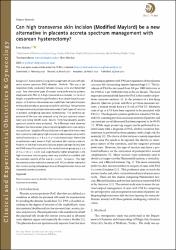Can high transverse skin incision (Modified Maylard) be a new alternative in placenta accreta spectrum management with cesarean hysterectomy?
Citation
Akbaba E. Can high transverse skin incision (modified maylard) be a new alternative in placenta accreta spectrum management with cesarean hysterectomy? Clin Exp Obstet Gynecol [Internet]. 2021;48(3):686-90.Abstract
Background: Assess optimal surgical management of cases with placenta accreta spectrum (PAS) disorder. Methods: This was a retrospective study conducted between January 2012 and November 2020. Two alternative types of incision were performed in patients diagnosed with PAS. (1) A high transverse skin incision, 12-14 cm in length, was performed through the skin 5-8 cm above the pubic symphysis. (2) A vertical skin incision was made from the xiphoid process to the pubic symphysis, passing around the umbilicus. We compared intraoperative and postoperative outcomes of both types of incisions in patients undergoing caesarean hysterectomy. The aesthetic appearance of the scar was assessed using the scar cosmesis assessment and rating (SCAR) scale. Results: Forty-four placenta accreta spectrum patients were evaluated. No differences were observed between the skin incision groups regarding exploration and surgical manipulation. Lengths of hospitalization and operative times were less in patients undergoing high transverse skin incision compared to vertical incision (5.5±1.1, 8.0±1.1, p = 0.03; respectively). Wound site complications were lower in high transverse skin incision patients. Patients in the high transverse incision group had significantly better SCAR scores than patients in the vertical incision group (3.3±0.9 vs 11.4 ± 1.8; p < 0.001) and a significantly higher proportion in the high transverse incision group were very satisfied or satisfied with the cosmetic aspects of the scar (p = 0.001). Conclusion: The high transverse incision method in women with PAS is a better method of skin incision giving reduced operative and hospitalisation times and improved cosmetic outcomes.


















